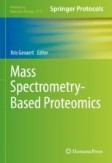Search
Search Results
-
Recombinant Glycoproteins Methods and Protocols
This detailed volume explores the production and purification of glycoproteins for therapeutic use or basic research, as well as the necessary...
-
Preparation, characterization and application of boronic acid functionalized porous polymer for glycoproteins enrichment from biological samples
Boronic acids are known for their specific affinity to glycoproteins via cis-diol groups of glycan under alkaline conditions. Here in this work, we...

-
Modification of N-Linked Glycan Sites in Viral Glycoproteins
Post-translational modification of proteins by the addition of sugar chains, or glycans, is a functionally important hallmark of proteins trafficked...
-
A high-throughput screening platform for enzymes active on mucin-type O-glycoproteins
Mucin-type O-glycosylation is a post-translational modification present at the interface between cells where it has important roles in cellular...

-
Production of Influenza Virus Glycoproteins Using Insect Cells
The baculovirus/insect cell expression system is a very useful tool for reagent and antigen generation in vaccinology, virology, and immunology. It...
-
Production and Purification of Hantavirus Glycoproteins in Drosophila melanogaster S2 Cells
Hantaviruses, are rodent-borne viruses found worldwide that are transmitted to humans through inhalation of contaminated excreta. They can cause a...
-
Systems-Wide Site-Specific Analysis of Glycoproteins
Glycosylation is one of the most common and complex post-translation modifications that influence the structural and functional properties of...
-
Cell-Free Systems for the Production of Glycoproteins
Cell-free protein synthesis (CFPS), whereby cell lysates are used to produce proteins from a genetic template, has matured as an attractive...
-
Preparation, Physicochemical and Hypoglycemic Properties of Natural Selenium-Enriched Coarse Tea Glycoproteins
Various functional components in tea have been well developed, but less research has been explored on glycoproteins in tea. In this paper, three...

-
Horner–Wadsworth–Emmons olefination of proteins and glycoproteins
Chemo-selective modifications of proteins are fundamental to the advancement of biological and pharmaceutical sciences. The search for biocompatible...

-
Production and Purification of Filovirus Glycoproteins
Ebola (EBOV) and Marburg (MARV) viruses cause hemorrhagic fever disease in humans and non-human primates (NHPs) with case-fatality rates as high as...
-
Mass Spectrometry of Glycoproteins Methods and Protocols
This volume presents methods used for the analysis of glycoproteins at different levels—intact, subunit, glycopeptide, and monosaccharide--, and...
-
Recent Advances Toward Engineering Glycoproteins Using Modified Yeast Display Platforms
Yeast are capable recombinant protein expression hosts that provide eukaryotic posttranslational modifications such as disulfide bond formation and...
-
A double boronic acid affinity “sandwich” SERS biosensor based on magnetic boronic acid controllable-oriented imprinting for high-affinity biomimetic specific recognition and rapid detection of target glycoproteins
Transferrin (TRF), recognized as a glycoprotein clinical biomarker and therapeutic target, has its concentration applicable for disease diagnosis and...

-
Improved detection and recognition of glycoproteins using fluorescent polymers with a molecular imprint based on glycopeptides
Highly specific novel glycopeptide-based fluorescent molecularly imprinting polymers (g-FMIPs) were constructed to recognize and determine the target...

-
Mutational heterogeneity in spike glycoproteins of severe acute respiratory syndrome coronavirus 2
The novel coronavirus SARS-CoV-2 (severe acute respiratory syndrome coronavirus 2) has led to a global crisis by infecting millions of people across...

-
Formation and fragmentation of doubly and triply charged ions in the negative ion spectra of neutral N-glycans from viral and other glycoproteins
Structural determination of N -glycans by mass spectrometry is ideally performed by negative ion collision-induced dissociation because the spectra...

-
Analysis of Glycoproteins by ATR-FTIR Spectroscopy: Comparative Assessment
FTIR spectroscopy has been widely used to characterize biopharmaceuticals for many years, in particular to analyze protein structure. More recently,...
-
Endoplasmic reticulum-quality control pathway and endoplasmic reticulum-associated degradation mechanism regulate the N-glycoproteins and N-glycan structures in the diatom Phaeodactylum tricornutum
Tunicamycin inhibits the first step of protein N-glycosylation modification. However, the physiological, transcriptomic, and N-glycomic effects of...

-
Analysis of Intact Glycoproteins by Matrix-Assisted Laser Desorption/Ionization Time-of-Flight Mass Spectrometry
Matrix-assisted laser desorption/ionization time-of-flight mass spectrometry (MALDI-TOF MS) can be regarded as a key tool to rapidly obtain molecular...
